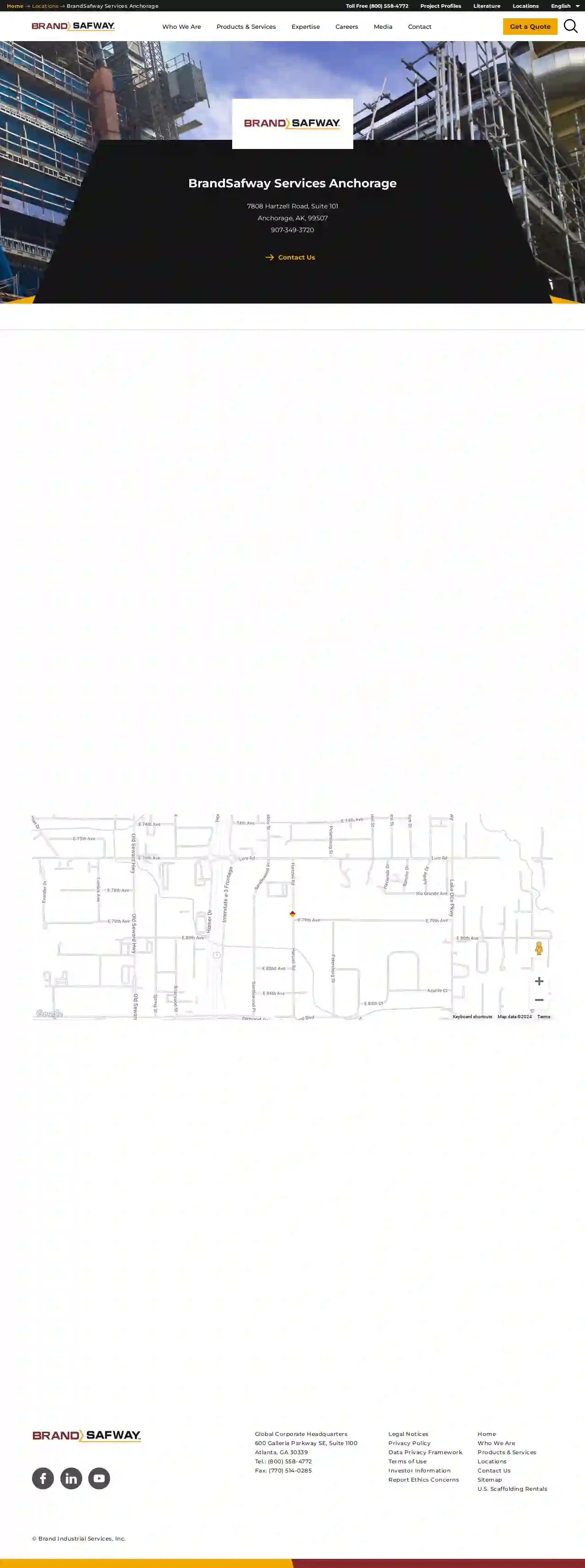Scaffolding Companies Knik-Fairview
Top Scaffolding Erectors in Knik-Fairview
Get 3 FREE Scaffolding Experts quotes for your project today! Compare profiles, reviews, accreditations, portfolio, etc... and choose the best offer.

BrandSafway Services Anchorage
3.77 reviews1000 W 3rd Ave, Suite 100, 1000 W 3rd Ave Suite 100, Anchorage, 99501, USBrandsafway is a leading provider of comprehensive safety training and consulting services in Anchorage, Alaska. With a proven track record of success, we are dedicated to helping businesses of all sizes create a safer and more productive work environment. Our team of experienced safety professionals offers a wide range of services, including OSHA compliance training, hazard identification and control, safety program development, and emergency response planning. We are committed to providing our clients with the highest quality training and consulting services, tailored to their specific needs and industry requirements. At Brandsafway, we believe that safety is everyone's responsibility, and we are passionate about helping our clients achieve their safety goals.
- Services
- Why Us?
Get Quote- Sp
Spenard Builders Supply
4.280 reviewsAnchorage, US- Services
- Why Us?
Get Quote - Th
The Home Depot
4.1548 reviewsAnchorage, US- Services
- Why Us?
Get Quote - Ar
Arrowhead Scaffold
4.511 reviewsAnchorage, US- Services
- Why Us?
Get Quote - Th
The Home Depot
3.9722 reviewsAnchorage, US- Services
- Why Us?
Get Quote - Eq
Equipment Source Inc
3.819 reviewsAnchorage, US- Services
- Why Us?
Get Quote - PR
PRO Scaffold Services Inc
4.115 reviewsAnchorage, US- Services
- Why Us?
Get Quote - Th
The Home Depot
4962 reviewsAnchorage, US- Services
- Why Us?
Get Quote - Lo
Lowe's Home Improvement
4.1994 reviewsAnchorage, US- Services
- Why Us?
Get Quote - Lo
Lowe's Home Improvement
4.1900 reviewsAnchorage, US- Services
- Why Us?
Get Quote
Over 2,353+ Scaffolding Contractors onboarded
Our scaffolding pros operate in Knik-Fairview and surrounding areas!
ScaffoldingHQ has curated and vetted Top Scaffolding Companies near Knik-Fairview. Find a trustworthy contractor today.
Frequently Asked Questions About Scaffolding Companies
- A larger, more complex structure typically used for accessing multiple levels of a building.
- Offers greater height and versatility.
- Often used for construction, renovation, and maintenance.
- Smaller, portable platforms usually used for tasks at a single level.
- Commonly used for painting, plastering, or light repairs.
- Can be rolling or stationary.
- Encroaches onto public property (sidewalks, roads): Permits are usually needed from the local council or highway authority.
- Exceeds a certain height: Scaffolding above a specified height often requires a permit.
- Is erected in a conservation area or near a listed building: Special considerations and permits may apply.
- A temporary structure with a larger platform for workers and materials.
- Offers greater stability and working space.
- Suitable for tasks requiring movement and multiple workers.
- Used for higher elevations and more complex projects.
- Used for reaching specific points at height for short durations.
- Less stable than scaffolding, requiring more caution and balance.
- Not suitable for tasks involving heavy materials or extended work periods.
- Mobile Elevated Work Platforms (MEWPs): Scissor lifts, boom lifts, and other MEWPs offer flexible access for specific tasks.
- Mast Climbing Work Platforms (MCWPs): Ideal for high-rise construction, providing a stable working platform that can be raised incrementally.
- Suspended Access Equipment: Ropes and harnesses used for specific tasks like window cleaning or façade repairs.
- Ladders and Step Ladders: For shorter durations and limited working heights, provided they are used safely and appropriately.
What is the difference between scaffolding and staging?
Scaffolding:
Do I need a permit for scaffolding in the USA?
What is the difference between a scaffold and a ladder?
Scaffolding:
What are some alternatives to traditional scaffolding?
What is the difference between scaffolding and staging?
Scaffolding:
- A larger, more complex structure typically used for accessing multiple levels of a building.
- Offers greater height and versatility.
- Often used for construction, renovation, and maintenance.
- Smaller, portable platforms usually used for tasks at a single level.
- Commonly used for painting, plastering, or light repairs.
- Can be rolling or stationary.
Do I need a permit for scaffolding in the USA?
- Encroaches onto public property (sidewalks, roads): Permits are usually needed from the local council or highway authority.
- Exceeds a certain height: Scaffolding above a specified height often requires a permit.
- Is erected in a conservation area or near a listed building: Special considerations and permits may apply.
What is the difference between a scaffold and a ladder?
Scaffolding:
- A temporary structure with a larger platform for workers and materials.
- Offers greater stability and working space.
- Suitable for tasks requiring movement and multiple workers.
- Used for higher elevations and more complex projects.
- Used for reaching specific points at height for short durations.
- Less stable than scaffolding, requiring more caution and balance.
- Not suitable for tasks involving heavy materials or extended work periods.
What are some alternatives to traditional scaffolding?
- Mobile Elevated Work Platforms (MEWPs): Scissor lifts, boom lifts, and other MEWPs offer flexible access for specific tasks.
- Mast Climbing Work Platforms (MCWPs): Ideal for high-rise construction, providing a stable working platform that can be raised incrementally.
- Suspended Access Equipment: Ropes and harnesses used for specific tasks like window cleaning or façade repairs.
- Ladders and Step Ladders: For shorter durations and limited working heights, provided they are used safely and appropriately.